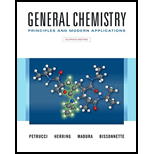
Concept explainers
(a)
Interpretation:
The Lewis structure of H2O needs to be determined.
Concept introduction:
Lewis structures are also known as Lewis dot structures or electron dot structures. These provide a simplified representation of the valence shell electrons in a molecule. The covalent bonding of a molecule or ion is represented using simple representation as dots. The sharing of electrons is done to get a stable octet structure. These shared electrons are represented as dots and this represents each atom to have eight electrons. The connectivity between the atoms within a molecule is easily represented via a Lewis structure. It is the valence electrons that are represented along with the lone pairs that can also be indicated and identified in the molecule structure.
(b)
Interpretation:
The Lewis structure of CH3NH2 needs to be drawn.
Concept introduction:
A Lewis dot structure is to represent valence shell electrons in a simplified manner. The dots represented here indicate the covalent bonds. These dots also indicate the electrons of individual atoms that are shared. These dots are mostly the valence electrons of the atom. It represents lone pairs as well. The dots between the two atoms represent the bond and dots present on the atom represent a lone pair of electrons.
(c)
Interpretation:
The Lewis structure of ONO- needs to be determined.
Concept introduction:
A Lewis dot structure is to represent valence shell electrons in a simplified manner. The dots represented here is to indicate the covalent bonds. The dots indicate the electrons of individual atoms that are shared. These dots are mostly the valence electrons of the atom. It represents lone pairs as well. The dots between the two atoms represent the bond and dots present on the atom represents a lone pair of electrons.
(d)
Interpretation:
The Lewis structure of SCN- needs to be determined.
Concept introduction:
A Lewis dot structure is to represent valence shell electrons in a simplified manner. The dots represented here is to indicate the covalent bonds. The dots indicate the electrons of individual atoms that are shared. These dots are mostly the valence electrons of the atom. It represents lone pairs as well. The dots between the two atoms represent the bond and dots present on the atom represent a lone pair of electrons.
Want to see the full answer?
Check out a sample textbook solution
Chapter 24 Solutions
Mastering Chemistry With Pearson Etext -- Standalone Access Card -- For General Chemistry: Principles And Modern Applications (11th Edition)
- Classify each ligand as monodentate, bidentate, and so on. (a) (CH3)3P (b) H2N(CH2)2NH(CH2)2NH2 (c) H2Oarrow_forwardPlatinum(II) forms many complexes, among them those with the following ligands. Give the formula and charge of each complex. (a) two ammonia molecules and one oxalate ion (C2O42-) (b) two ammonia molecules, one thiocyanate ion (SCN-), and one bromide ion (c) one ethylenediamine molecule and two nitrite ionsarrow_forwardAn aqueous solution of [Rh(C2O4)3]3− is yellow. Predict the approximate wavelength and predominant color of light absorbed by the complex.arrow_forward
- Two different compounds are known with the formula Pd(py)2Cl2, but there is only one compound with the formula Zn(py)2Cl2. The symbol py is for pyridine, a mono-dentate ligand. Explain the differences in the Pd and Zncompounds.arrow_forwardSpecify whether the following complexes have isomers.. (a) tetrahedral [Ni(CO)2(Cl)2]. (b) trigonal bipyramidal [Mn(CO)4NO]. (c) [Pt(en)2Cl2]Cl2arrow_forwardWhat types of isomers are possible for the following compounds or complex ions? (a) K[Co(NH3)2Cl4] (b) Pt(en)Cl2 (square-planar) (c) [Co(NH3)5Cl]2+ (d) [Ru(phen)3]Cl3 (e) Na2[MnCl4] (tetrahedral) (f) [Co(NH3)5NO2)2+arrow_forward
- Which of the following ligands is expected to be monodentate, and which might be polydentate? (a) CH3NH2 (b) CH3CN (c) N3 (d) en (e) Br (f) phenarrow_forwardOne of the following nitrogen compounds or ions is not capable of serving as a ligand: NH4+, NH3, NH2. Identify this species, and explain your answer.arrow_forward
 Chemistry & Chemical ReactivityChemistryISBN:9781337399074Author:John C. Kotz, Paul M. Treichel, John Townsend, David TreichelPublisher:Cengage Learning
Chemistry & Chemical ReactivityChemistryISBN:9781337399074Author:John C. Kotz, Paul M. Treichel, John Townsend, David TreichelPublisher:Cengage Learning Chemistry & Chemical ReactivityChemistryISBN:9781133949640Author:John C. Kotz, Paul M. Treichel, John Townsend, David TreichelPublisher:Cengage Learning
Chemistry & Chemical ReactivityChemistryISBN:9781133949640Author:John C. Kotz, Paul M. Treichel, John Townsend, David TreichelPublisher:Cengage Learning General Chemistry - Standalone book (MindTap Cour...ChemistryISBN:9781305580343Author:Steven D. Gammon, Ebbing, Darrell Ebbing, Steven D., Darrell; Gammon, Darrell Ebbing; Steven D. Gammon, Darrell D.; Gammon, Ebbing; Steven D. Gammon; DarrellPublisher:Cengage Learning
General Chemistry - Standalone book (MindTap Cour...ChemistryISBN:9781305580343Author:Steven D. Gammon, Ebbing, Darrell Ebbing, Steven D., Darrell; Gammon, Darrell Ebbing; Steven D. Gammon, Darrell D.; Gammon, Ebbing; Steven D. Gammon; DarrellPublisher:Cengage Learning Chemistry: Principles and PracticeChemistryISBN:9780534420123Author:Daniel L. Reger, Scott R. Goode, David W. Ball, Edward MercerPublisher:Cengage Learning
Chemistry: Principles and PracticeChemistryISBN:9780534420123Author:Daniel L. Reger, Scott R. Goode, David W. Ball, Edward MercerPublisher:Cengage Learning Chemistry: Principles and ReactionsChemistryISBN:9781305079373Author:William L. Masterton, Cecile N. HurleyPublisher:Cengage Learning
Chemistry: Principles and ReactionsChemistryISBN:9781305079373Author:William L. Masterton, Cecile N. HurleyPublisher:Cengage Learning Chemistry: The Molecular ScienceChemistryISBN:9781285199047Author:John W. Moore, Conrad L. StanitskiPublisher:Cengage Learning
Chemistry: The Molecular ScienceChemistryISBN:9781285199047Author:John W. Moore, Conrad L. StanitskiPublisher:Cengage Learning





